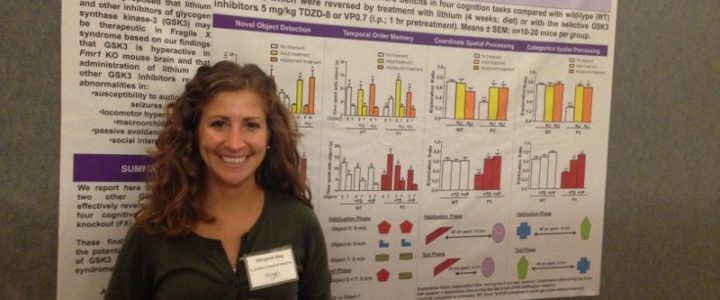The FRAXA Drug Validation Initiative (FRAXA-DVI) provides speedy, cost-effective, objective preclinical testing of potential Fragile X treatments. FRAXA-DVI uses in-vitro systems, behavior batteries, and gene expression and peripheral biomarker platforms to validate investigational new drugs and repurposed available compounds in Fragile X syndrome (FXS).
Read more2014 Grants
Cellular-Specific Therapeutic Targeting of Inhibitory Circuits in Fragile X Syndrome

Studies have shown that the function of inhibitory networks is disturbed in Fragile X. This abnormality is not well understood but appears to be secondary to abnormalities in metabotropic glutamate and endocannabinoid systems. With a $90,000 grant from FRAXA, Dr. Molly Huntsman’s team examined how these networks interact and how inhibitory deficits can best be remedied.
Read moreNKCC1 Inhibitor Bumetanide Corrects Synaptic and Circuit Hyperexcitability in Fragile X Mouse Model

With $258,000 in grants since 2013 from FRAXA Research Foundation, Dr. Anis Contractor and Dr. Qionger He at Northwestern University are exploring the potential of the available drug bumetanide to correct altered GABA signalling in a mouse model of Fragile X syndrome.
Read moreClinical Trial of Ganaxolone in Patients with Fragile X Syndrome

With a $90,000 grant from FRAXA Research Foundation funded during 2014-2015, Dr. Frank Kooy and colleagues at the University of Antwerp are conducting a double blind crossover trial of ganaxolone in patients with Fragile X syndrome. Results of this study were mixed (see Marinus: Results from Phase 2 Exploratory Clinical Study Support Continued Development of Ganaxolone in Fragile X Syndrome.)
Read moreFragile X Mutant Mouse Models

With $375,000 in grants from the FRAXA Research Foundation since 2009, Dr. David Nelson has developed an impressive array of advanced mouse models of Fragile X, at Baylor College of Medicine. These models are available to investigators worldwide on request. This resource has been essential for a broad, rapid distribution of Fragile X and related gene mouse models and has increased the pace of Fragile X research.
Read moreFruit Flies to Model and Test Fragile X Treatments

Dr. Jongens and his collaborators have found an insulin-like protein in the fly brain that is overexpressed in the Fragile X mutant fly, leading to increased activity of the insulin signaling pathway. Furthermore, they found that certain behavioral patterns in the Fragile X flies can be rescued by expressing the FX gene just in insulin producing neurons in the fly brain. In the mutant, there are other changes in the signaling pathways, including a decrease in cAMP and elevation in PI3K, mTOR, Akt and ERK activity. They now propose to study 2 medicines used for diabetes: pioglitazone (increases cAMP and decreases Akt and ERK) and metformin (inhibits mTOR), in flies and mice to validate the potential efficacy of these novel therapeutics for Fragile X.
Read moreAnalysis of Developmental Brain Dysfunction in Families

FRAXA Research Foundation is proud to make a grant of $90,000 over 2014-2015 to Margaret King, PhD. The goal of this project is to identify new approaches to clinical trial design for Fragile X pharmaceuticals.
Read moreInhibitors of STEP as a Novel Treatment of Fragile X Syndrome

With a $349,000 grant from FRAXA Research Foundation from 2008-2015, Dr. Paul Lombroso and his team at Yale University researched if inhibiting STEP could reduce behavioral abnormalities in Fragile X syndrome. Results published.
Read moreTargeting the Endocannabinoid System in Adult Fragile X Mice

With a $90,000 grant from the FRAXA Research Foundation from 2013-2014, Dr. Andres Ozaita led a team to test rimonabant’s ability to blockade the CB1 receptor. Blocking CB1 has shown potential to reverse most symptoms of disease in mice bred to mimic Fragile X syndrome.
Read morePhase 1 Clinical Trial of Mega Green Tea Extract in Fragile X Syndrome

With a $124,000 grant from the FRAXA Research Foundation from 2012-2014, Dr. Mara Dierssen and Dr. Rafael de la Torre conducted preclinical studies in Fragile X knockout mice and a clinical trial in Fragile X patients using Mega Green Tea Extract, which contains 45% by weight epigallocatechin gallate (EGCG).
Read moreFunctional Interplay Between FMRP and CDK5 Signaling
With a $180,000 grant from the FRAXA Research Foundation over 2011-2014, Dr. Yue Feng and Dr. Wenqi Li at Emory University will study CDK5 pathway function and regulation in an effort to break down whether and how CDK5 signaling is affected by the loss of the Fragile X protein, FMRP, in the Fragile X mouse model.
Read moreComputational Analysis of Neural Circuit Disruption in Fragile X Model Mice

Computer modeling of the brain offers the hope of predicting how the brain responds to varying conditions, but these models have been rather primitive until recently. The Sejnowski team at the Salk Institute, who specialize in computational models of neural networks, will take the results of previous FRAXA-funded projects and incorporate them into their advanced computer models of brain function.
Read moreSynaptic Characterization of Human Fragile X Neurons

With a $90,000 grant from FRAXA Research Foundation over 2013-14, Dr. Marius Wernig and Dr. Samuele Marro at Stanford analyzed homeostatic plasticity and regulation of synaptic strength by retinoic acid. If the results are encouraging, they will move forward with testing whether available RA antagonists can alleviate observed abnormalities in these cells.
Read moreBcl-xL Inhibition as a Therapeutic Strategy for Fragile X Syndrome

Scientists have found increases in the numbers of neurons in brain regions of autistic children, suggesting a problem in developmental programmed cell death pathways. One of the most important effectors of neuronal survival during brain development is the “anti-cell death” protein Bcl-xL. While the normal function of Bcl-xL is to maintain a healthy number of neurons and synapses, over-expressed Bcl-xL can cause an overabundance of synaptic connections. This may be happening in Fragile X.
Read moreSeizures in Fragile X Syndrome and Therapeutic Potential of NMDA Receptor Antagonists

With a $90,000 grant from the FRAXA Research Foundation, Dr. Robert Wong is investigating how seizures are generated in Fragile X neurons. More generally, he is looking at how synapses are modified to enable learning and memory and how this process is impaired in Fragile X.
Read morePotassium Channel Modulators to Treat Fragile X

With $246,000 in funding from FRAXA over 2012-2014, the Yale University team of Leonard Kaczmarek, PhD, showed that loss of FMRP leads to an increased Kv3.1 potassium currents and decreased Slack potassium currents in neurons. Both of these changes impair timing of action potentials in auditory neurons (and likely others throughout the brain). The team also found that the firing pattern of neurons in response to repeated stimulation is severely abnormal in Fragile X mice. Based on these results, they are collaborating with the UK-based company Autifony to develop and test advanced compounds which may reverse these deficits.
Read more
